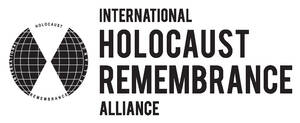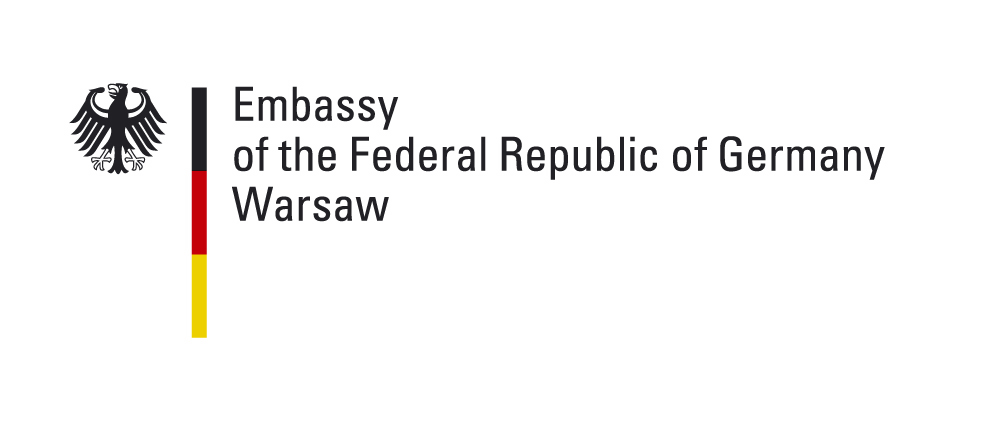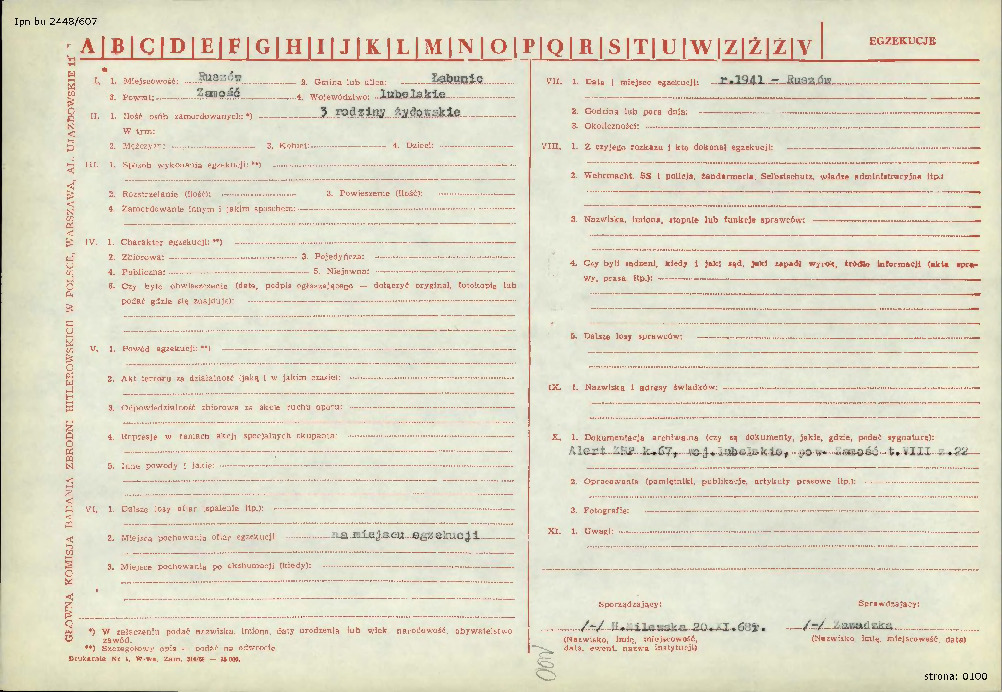Ruszów
Borough of Łabunie, Zamojski District, Lubelskie VoivodshipType of place
A wasteland at a crossroad.Information about the crime
On May 10, 2021, we carried out a site inspection of the Jewish war grave in Ruszów. Members of two Jewish families who lived in the village until the war, from 6 to 10 people murdered in the fall of 1942, were buried in the common grave. The grave is located in a wasteland belonging to the borough at the junction of two roads. It is possible that the bones were displaced and the original grave was destroyed during the construction of a new road and a fire tank after the war. During the inspection, we met an inhabitant of Ruszów, who described the place where the murdered Jews were buried in 1942:
“Two or three times a year, water rose and a vortex was formed here. The water was going down, there was no flood bank here. The water flowed out onto the meadows, sometimes for several kilometers. There was a vortex here, and the water was depositing the silt. People took it to their farms. They took it from this pit. When they killed those Jews here, they threw them on the ladder and buried them. Then people stopped taking sand from here. Only the children were skiing here. (Ruszów, May 10, 2021)
An inhabitant of Ruszów interviewed Agnieszka Piela in 2005, confirms the murdered Jews were buried in an area flooded with water: “The Jews lived on a hill in Ruszów. The Germans shot them all, here at the corner, on the way to school. There was water there, even after the liberation. They were killed and buried in the same place. It was before the displacement in 1941. I remember two Jewish families. There was a woman named Łajka, who used to come to us. […] All the people knew about this murder. [but no one wants to talk about it – red.]” (Igła. Informator Gminy Łabunie, 2005)
In 1968, the inhabitants of Ruszów testified before the District Public Prosecutor’s Office in Zamość. They witnessed the execution in autumn 1942. The testimonies were later included in the documents of the investigation conducted by The Regional Commission for the Examination of German Crimes in Zamość.
Stefania M .: “Probably in 1941, the Germans shot 6 adult Jews and 3 children at one time. I don’t remember their names. They were farmers from Ruszów. […] They were executed in a barn. The Germans ordered the local people to bury the killed Jews in a ditch, next to the place of execution. […] The place of execution and burial was not commemorated.” (pp. 302-303)
Felicjan Sz.: “During the occupation in August 1942, Szpringer in the SS uniform and five men in black uniforms came to the village. On that day, they murdered Abram Lerner’s family, consisting of 4 people, including 2 children. I need to clarify, it was 1 adult, Lerner’s father, who was murdered. Lerner’s wife was not killed that day, as she was not at home at the time. I don’t remember the second family, I only remember that one of them was named Moszek. Two children, aged 2-6, and Moszek’s wife, Ruchla, aged 35, were killed then. I don’t remember if Moszek also died that day. Both these families came from the countryside, they were farmers, and had their own shops.” (pp. 308-309)
Tadeusz K.: “I remember that in August 1940 or 1941 some people, probably the Gestapo, came to the village by taxi and took 4 Poles: Andrzej Lis, Danaj – I don’t remember the first name, Jan Magdziak – the mayor, Józef Lupa – mayor’s assistant and a Jew named Abram [Abram Zycer, called Jabramek, born in 1918 in Ruszów, the son of Lejb and Chaja née Gutcherz, died in Auschwitz on February 26, 1942]. I don’t know where they were taken, because none of them came back.” (pp. 210-211)
“In 1942, while I was digging potatoes in my field, I heard screams and shots. I saw a fifteen-year-old Jewish girl running away from the village. A man in a green uniform chased her. When he approached her, he hit her with a rifle butt and led her back to the village. I found out that the Jews who lived in Ruszów were murdered. In total, about 10 people were murdered that day. I don’t remember their family names. I only remember the name of Mendel, Abraham Lerner’s parents, Abram and Lejba were in the second family. I don’t remember any other names. (pp. 210-211)
Bronisław Z .: “After the harvest in 1941, Beker and Szpringer, who lived in Sitaniec, came to Ruszów and murdered two Jewish families, eight people in total. Lejba with his wife and daughter and Abram with his wife and son were among the murdered. Two Jewish men who came to Ruszów to hide with local Jews were killed on the same day. They were buried by the local people in Ruszów. The place of the burial has not been commemorated. There was no exhumation.” (p. 342)
Bolesław M.: “Before the deportation, probably in 1941, three SS-men, including Szpringer from Sitaniec, came to Ruszów in autumn and shot two Jewish families, 8 people in total. They were Lejb’s and Abram’s families. They lived in Ruszów, they were farmers. Two of the victims were old people, aged over 70, the others were 10 to 40 years old. I remember that a ten-year-old girl tried to run away, about 20 meters from the place of the execution, but one of the SS men shot her. On the same day, two little girls and an adult Jewish woman were also shot. I don’t know their names because they came from Zamość. The Jews murdered in Ruszów were buried by the local people in the pit that had not been exhumed. The place of execution and burial has not been commemorated.” (pp. 314-315)
Sources
Transkrypcje
Contact and cooperation
We are still looking for information on the identity of the victims and the location of Jewish graves in Ruszów. If you know something more, write to us at the following address: fundacjazapomniane@gmail.com.
Bibliography
IPN BU 2448/608 pp. 1-4, Questionnaire of The Chief Commission for the Examination of German Crimes in Poland and The Regional Commission for the Examination of German Crimes in Warsaw, collected in the years 1968-1972, questionnaires concerning the lubelskie province– VIII, Zamość county: questionnaires.
IPN BU 2448/607 Questionnaire of The Chief Commission for the Examination of German Crimes in Poland and The Regional Commission for the Examination of German Crimes in Warsaw, collected in the years 1968-1972, questionnaires concerning the lubelskie province– VIII, Zamość county: questionnaires.
Igła. Informator Gminy Łabunie, January-March 2015 pp. 1, 4, 5
Recording of the Zapomniane Foundation (audio file), an anonymous inhabitant of the village of Ruszów, keywords: Jewish grave in Ruszów; exp. Agnieszka Nieradko, Marek Kołcon and Andrzej Jankowski, Ruszów, 10 May 2021.
The Register of Killing Sites and Crimes committed by the Germans in Poland between 1939 and 1945, zamojskie voivodeship, Warsaw, 1994
Files on crimes committed by the Germans in Zamojszczyzna.
We have collected the materials about this village thanks to the funding provided by the International Holocaust Remembrance Alliance as part of the project “The rural Holocaust. Collecting and safeguarding the never recorded testimonies 100 forgotten Jewish graves 2021-2022” and also thanks to the support of the Embassy of the Federal Republic of Germany in Warsaw.


 Ruszów zdjęcie lokalizacji 1
Ruszów zdjęcie lokalizacji 1 Ankieta Głównej Komisji Badania Zbrodni Hitlerowskich - Ruszów
Ankieta Głównej Komisji Badania Zbrodni Hitlerowskich - Ruszów Ruszów transkrypcja nagrania
Ruszów transkrypcja nagrania